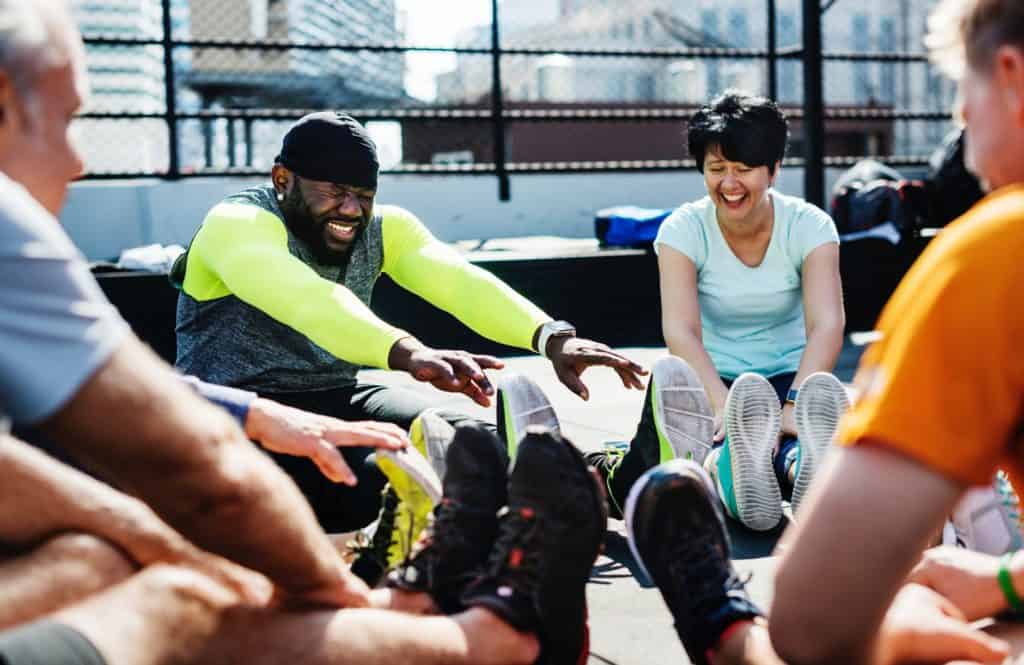A Beginners Guide to Outdoor Exercise
If you’re like most people, the thought of exercising outdoors is probably more appealing than doing it in a stuffy gym. I built an entire gym in my basement but given the choice of using it and getting outside I will choose outside (almost) every time. And, if you’re already an avid fitness person, then you know that there are many benefits to getting your sweat on outside. But, outdoor exercise can be scary for beginners.
The warm weather and sunshine can be an excellent motivator for getting active–and staying active. Now that it is starting to get a bit nicer out and the threat of snow is disappearing for a large part of the country, let’s dig into how to make outdoor workouts better.
Here are some ways to do that:
Getting Started with Outdoor Fitness
Getting started with outdoor fitness is easy. All you need is the right gear and the great outdoors. Depending on your goal, what kind of outdoor setting you need changes.
Find the right environment:
A gym has its benefits–you don’t have to worry about weather conditions or traffic jams–but there’s no substitute for working out outdoors when it comes to getting some fresh air and sunshine (not to mention vitamin D). But, where do you head?
When it comes to trail running or biking, mountain escapades, ruck marches, or prepping for most obstacle course runs, you probably want to stick closer to nature. The more natural the environment, the better the training.
Marathon runners, road races, and other similar activities are probably best done in or around city environments.
Strongman stuff can be done practically anywhere, while outdoor yoga needs flat, serene environments (unless you are into rage yoga or prefer to practice alongside goats like some people are known to do).
Use your best judgement for anything in between.
Choose your gear wisely:
The right shoes (or lack thereof) are crucial for any type of exercise, but they’re especially important when you’re exercising outside. If you don’t have a specialty pair for your specific goals yet that should be your very first stop.
Great hiking boots: Lowa Men’s Zephyr
My favorite running shoe: Brooks GTS ’22
The rest of the gear you need is determined by what you are going to be doing. Strongman workouts can be improvised anywhere. Pick up some logs, carry some rocks, find an old tire. Overall, fairly simple.
You probably need some specialized gear for other goals, though. Race bikes, yoga mats and blocks, ropes or chains, rucksacks, and kettlebells are all incredibly mobile and versatile pieces of equipment that can be used inside or out.
Creating an Outdoor Fitness Plan
If you’re a beginner over 30 looking to get back in shape and plan to include outdoor exercise, there are some important factors to consider. First, think the types of workouts you enjoy (or at least can tolerate) and will stick to. Some great options for outdoor workouts include hiking, running, cycling, and swimming.
There are other more specialized exercises you can throw in like tire flipping (if you have a tire), tree/rope climbing, skating, roller blading, and mountain climbing. Obviously, your goal dictates what you do. Indoor exercise is limited by equipment and space, but your imagination is the literal limiting factor with outdoor exercise.
Next, determine how frequently you will exercise. A good starting point is 3-4 times per week, with rest days in between. Each workout session should last at least 30 minutes, but can range up to an hour or more depending on your fitness level. Consider how high you are going to get your heart rate. Are you including mainly steady state, low impact exercises (walking)? High intensity, high impact exercises (HIIT)? Things that stress your Central Nervous System (Climbing)? Try to make it a good mix to avoid overtraining.
It’s important to tailor your outdoor fitness plan to your goals, but regardless of what those goals are, include some aspect of strength training AND cardio. Your body will thank you.
Additionally, make sure to warm up before each workout and cool down afterwards to prevent injury and reduce muscle soreness.
Lastly, don’t forget to track your progress. This can be as simple as recording the distance or time of your workouts, or using a fitness tracker to monitor your heart rate and other metrics. Seeing your progress over time can be incredibly motivating and help you stay on track with your fitness goals.
Remember, building an outdoor fitness plan is about finding what works for you and your lifestyle. Don’t be afraid to experiment with different activities and routines until you find a plan that you enjoy and can stick to long term. With consistency and dedication, you can achieve your fitness goals and enjoy the benefits of exercising outdoors.
Staying Motivated
Starting a fitness journey can be challenging, especially if you’re over 30 and trying to get back in shape. Throw in starting to get in some outdoor PT and it can be even tougher. Staying motivated is crucial to achieving your fitness goals. Here are a few tips to help you stay motivated while working out, whether inside or outside:
Set realistic goals: You need to set realistic goals that you can achieve. Start with small goals that you can accomplish easily, and gradually increase the intensity and duration of your workouts as you progress. This will help you stay motivated and avoid frustration. Crush a goal? Set another. Then another. Yesterdays mountains are todays hills or some cliché saying.
Find a workout buddy: Having a workout buddy can make exercising more fun and motivate you to stick to your fitness routine. You can encourage each other, hold each other accountable, and celebrate each other’s successes.
Reward yourself: Set up a reward system for yourself to help you stay motivated. Treat yourself to something you enjoy after reaching a fitness milestone, such as a new workout outfit or a massage.
Track your progress: Keep track of your progress to see how far you’ve come. Take photos, measurements, and keep a log of your workouts. Seeing your progress can be a great motivator to keep going.
Mix it up: Doing the same workout every day can become boring and demotivating. Mix up your routine by trying new things. This can help you stay engaged and excited about your fitness journey. Sick of running distance? Do sprints. Sick of sprints? Find a rockface (that you can manage) and climb it. Tons of new things to attempt, and life is worth living.
Remember, staying motivated on your fitness journey is essential to achieving your goals.
Tips for Staying Safe in the Sun
Number 1. The most important thing. Stay hydrated. The warmer weather can be dehydrating, but winter is even worse with the dry air. Make sure you’re drinking plenty of water throughout the day to avoid heat related issues. Drink plenty of water before, during, and after your workout.
Wear sunscreen. Even if it’s cloudy and cool outside, there’s still UV radiation coming from the sun that can cause skin damage and even cancer over time if you’re not careful about protecting yourself with sunscreen or other forms of sun protection (such as hats).
Wearing lightweight, breathable clothing can also help regulate your body temperature and prevent heat exhaustion in the summer.
In cold weather, dress in layers to keep your body warm and dry. Choose fabrics that wick moisture away from your skin to prevent sweating, which can lead to hypothermia. Protect your extremities by wearing gloves, a hat, and warm socks. If the weather conditions are extreme, consider exercising indoors or postponing your workout until conditions improve.
Adjust your routine to the temperature. If it’s hot out, avoid doing high-intensity workouts like sprinting or lifting heavy weights; instead opt for lighter exercises like walking at a brisk pace or riding an exercise bike indoors until your body has acclimated to exercising in higher temperatures. If it’s colder, take some extra time to warm up. You can avoid a lot of issues by doing these two things.
Avoid peak sun hours (10 a.m.-2 p.m.). Most heat injuries happen during peak sun hours in the summer. Avoid doing any strenuous activity outside when the sun is high up or the heat/humidity climb into oppressive numbers. Try to avoid exercising during the hottest parts of the day and take breaks in the shade if you start to feel overheated.
Regardless of the weather, it’s important to be aware of your surroundings and take precautions to stay safe. If you’re running or cycling near traffic, wear reflective clothing and stay alert. If you’re hiking or running on a trail, be mindful of obstacles and other hikers or animals. Some areas of the country have some pretty dangerous wildlife once you get out past where humans go regularly, so stay vigilant. Stay away from the murder mittens and slithering smilers that probably want to eat you.
Need some help?
Shape Success, Live Exceptionally
Hit that button, and get started today.
Making the Most of Outdoor Fitness
Outdoor exercise is a great way to get in shape and enjoy the fresh air and sunshine. However, if you want to make the most of your outdoor workouts, there are some important things you need to do:
Turn your workouts into a social activity. Bring along some friends if you can. Makes it a competition, or at least a joint adventure. Plus, you have the support structure already there if you need it and a buddy is present if you are injured.
Better than just bringing a friend along, take them to explore new places with you. New trails, higher mountains, different beaches and parks all scream to bring along a friend.
Another way to make the most of your outdoor exercise is to mix up your routine. Try different activities like hiking, running, cycling, or swimming to keep things interesting and challenge your body in new ways.
Lastly, and most importantly, don’t forget to stay hydrated and fuel your body with the right nutrients. Bring a water bottle with you on your outdoor workouts and consider bringing a healthy snack like a piece of fruit or a protein bar to keep your energy levels up. After the workout, focus on proper recovery through a good diet.
If you need some help on that avenue, please check out these articles:
The Importance of Protein in Your Diet
Let Us help You Out
At CONDITIONerd we are here to help you achieve better physical and mental health through exercise. Check out the plans we offer to our customers and see if you could benefit from working with our team. And if you have questions, you can always contact a CONDITIONerd team member.
Personal trainers, like those found here, can help guide you on your pathway towards reaching your fitness goals, whether that is getting bigger, stronger, faster, more lean, or just generally feeling better.
We can get you setup with a periodized workout plan, supplement information, and advice on nutrition to help you reach your goals.
The only thing you need is some motivation and a willingness to change some old habits.
Get into contact with us to find out what membership is right for you. In a CONDITIONerd program, you’ll be surrounded by others who can help you to get where you want to be.
Generally, our clients start to see some pretty awesome changes in 2-3 months time, some sooner.

